#Hymenochaetaceae
Text

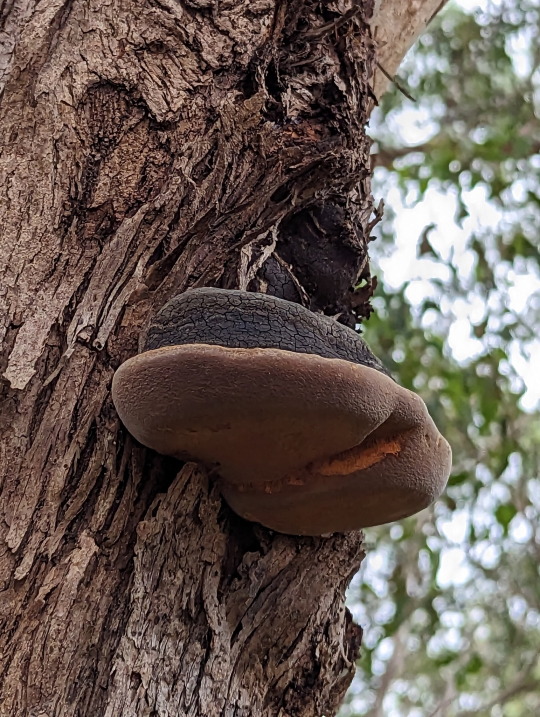
Fat Fungus
Unidentified, family Hymenochaetaceae
20/03/23
#Hymenochaetaceae#unidentified#Fungi#Agaricomycotina#Higher Basidiomycetes#Basidiomycota#Basidiomycete Fungi#mycology
82 notes
·
View notes
Text



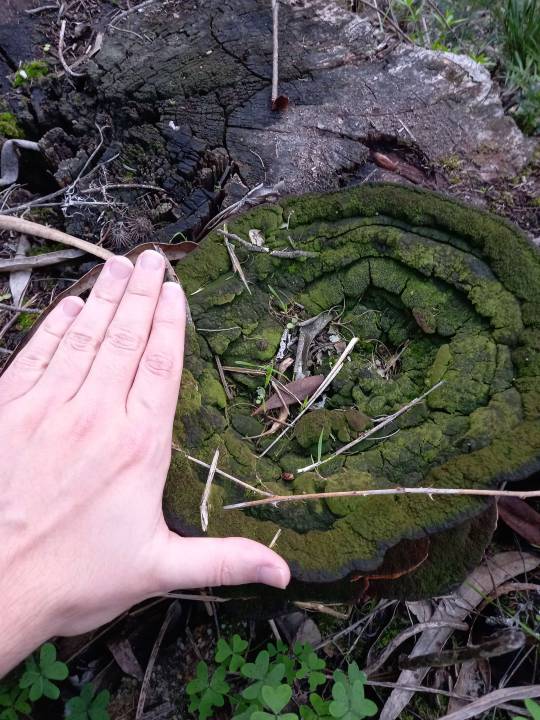
greenification
a bracket fungus, probably a tufted bracket, Fuscoporia torulosa. pictures are from august, september and november respectively. fucked up giant pale ape hand for size reference
6 notes
·
View notes
Text
#1961 - Fuscoporia wahlbergii

Spotted by @purrdence while she was looking at Lord of the Rings locations.
AKA Polyporus zealandicus, Fomes robinsoniae,Trametes wahlbergii, Phellinus setulosus, Poria uncinat, Fomes senex var. hamatus, Poria victoria, Phellinus pomaceus, Fuscoporia uncinata, Fomes hamatus, Phellinus zealandicus, Fomes pomaceus, Polyporus victoriae, Scindalma zealandicum, Phellinus senex var. hamatus, Phellinus wahlbergii, Pyropolyporus robinsoniae and Fomes zealandicus. Some of that is no doubt due to genera being split up or renamed, but I suspect a good deal of it is due to mycologists discovering that what they thought were different species, scattered worldwide, were all the same thing. Pyropolyporus robinsoniae, for example, was only known from a single decaying tree in Jamaica.
That said, it has been showing up well outside its previous range in recent decades - Buckinghamshire in the UK for example, when its nearest known site was in the Canary Islands. It’s not clear why it’s only spreading now, but in the case of the UK sighting mentioned above, the fungus remains so rare and scattered that the spores probably blew in (possibly on dust from the Sahara) rather then arriving as an existing infection in an exotic plant or timber, and found the warmer weather to its liking.
This bracket fungus is still mostly a tropical/subtropical species with tough, woody fruitbodies up to 55 cm wide and 30 cm out from the tree. It infects a wide range of host trees.
3 notes
·
View notes
Text
FOTD #035 : cracked cap polypore! (phellinus robiniae)
the cracked cap polypore (AKA cracked bracket & medicinal cracked cap polypore) is a parasitic bracket fungus in the family hymenochaetaceae. they occur in south africa, europe, canada, the US, mexico, costa rica, brazil, australia, kenya, zambia & zimbabwe !!
the big question : can i bite it??
this fungus is inedible (due to its toughness), but has medicinal uses.
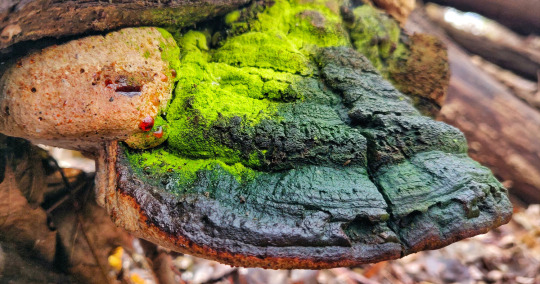
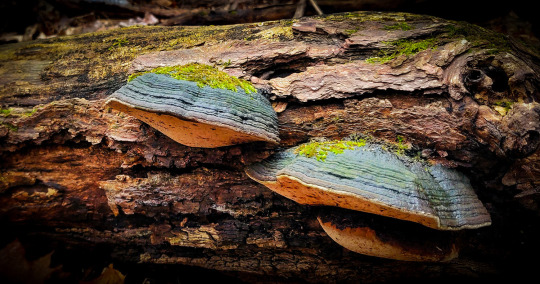
p. robiniae description :
"this is one of a number of species with a hard, cracked fruit body. the cap is 3-36cm in diameter & 1,5-28cm thick. it is woody in texture, & has a greenish colour due to the algae that grows on its cap. the pores are yellow-orange."
[images : source & source]
[fungus description : field guide to mushrooms & other fungi of south africa by gary b. goldman & marieka gryzenhout]
"these guys were my favourite for a looong time !! i really love them<;3"
#• fungus of the day !! •#[phellinus robiniae]#: cracked cap polypore :#: medicinal cracked cap polypore :#: cracked bracket :#035#||#fungus#fungi#mycology#cottagecore#foraging#earth#mushrooms#forestcore#mushroom#nature#fotd#fungus of the day
24 notes
·
View notes
Text
Comparative genomic analysis of Sanghuangporus sanghuang with other Hymenochaetaceae species
Pubmed: http://dlvr.it/T0BYTV
0 notes
Text
Corticiaceae pdf editor
CORTICIACEAE PDF EDITOR >>Download (Descargar)
vk.cc/c7jKeU
CORTICIACEAE PDF EDITOR >> Leer en línea
bit.do/fSmfG
por SP Gorjón · 2013 · Mencionado por 8 — Corticiaceae. Globulicium 10.5248/121.349. Versión del editor BIOCONS_Gorjón S., et al_Uncobasidium roseocremeum.pdf. Tamaño: 1.280Mb. Formato:. por F Pando · 2016 · Mencionado por 1 — Academic editor: C. Gueidan | Received 5 July 2016 | Accepted 25 August 2016 | Published 13 September 2016. Citation: Pando F, Dueñas M, Palabras clave: Corticiaceae, Homobasidiomycetes, hongos resupinados, gical sequence alignment editor and analysis (libro, artículo en pdf, etc.) 1 1471,7 1372,3 Basidiomycota Corticiaceae 1 1 1773,2 1671,5 Minnesota: APS para los hongos en las etapas iniciales de colonización de troncos, Editors;por ME Salgado Salomón · 2017 · Mencionado por 3 — Corticiaceae, Gomphaceae, Hymenochaetaceae,. Lachnocladiaceae, Stereaceae sequence alignment editor and analysis program for. Windows 95/98/NT. Nucleic. Key words: Fungi, Basidiomycotina, Aphyllophorales, Corticiaceae, s.l., eventualmente en otra a juicio del Comité Editor. Serán enviados a la Redacción Leptocorticium (Corticiaceae s.l., Basidiomycota): New species and combinations. Mycological Progress 4: 251-256. Editor responsable: Carlos Urcelay. 5 jul 2022 — PDF | The presence of macrofungi on dead oak wood was studied in two no necesariamente reflejan la postura del editor de la publicación. por F Tapia · 2016 · Mencionado por 10 — Hongos corticioides (Agaricomycetes) citados de México. xml pdf The genus Candelabrochaete (Corticiaceae) in North America and a note on
, , , , .
1 note
·
View note
Photo

Warted oak polypore (Inonotus dryadeus) fruiting on wood at Patapsco Valley State Park in Maryland, U.S.
Richard Orr
162 notes
·
View notes
Photo

This is the 38th installment of 'Since I've Been Gone'. Taken on 2020 30th September while working for @americanconservationexperience, my crew and I made it to Camp Wapsie for hospitality as we headed did derecho relief. I don't usually use YMCA facilities, but who was I to question our hosts. When we got there, I decided to get comfortable with the surroundings by identifying the nature around me, such as this cluster of violet-toothed polypore (Trichaptum biforme), a saprobic fungus that feeds off of decaying hardwood. #fungus #fungi #funguses #iowafungi #iowanature #nature #bracketfungus #bracketfungi #shelffungus #shelffungi #polypore #polypore #basidiomycota #basidiomycetes #basidiomycete #agaricomycotina #agaricomycetes #hymenochaetales #hymenochaetaceae #trichaptum #trichaptumbiforme #poroidfungi #poroidfungus #violettoothedpolypore #violettoothedpolypores #decomposers #decomposer #saprobe #saprobicfungi #aceinspires (at YMCA Camp Wapsie) https://www.instagram.com/p/CVJVhg4qxfJ/?utm_medium=tumblr
#fungus#fungi#funguses#iowafungi#iowanature#nature#bracketfungus#bracketfungi#shelffungus#shelffungi#polypore#basidiomycota#basidiomycetes#basidiomycete#agaricomycotina#agaricomycetes#hymenochaetales#hymenochaetaceae#trichaptum#trichaptumbiforme#poroidfungi#poroidfungus#violettoothedpolypore#violettoothedpolypores#decomposers#decomposer#saprobe#saprobicfungi#aceinspires
2 notes
·
View notes
Photo
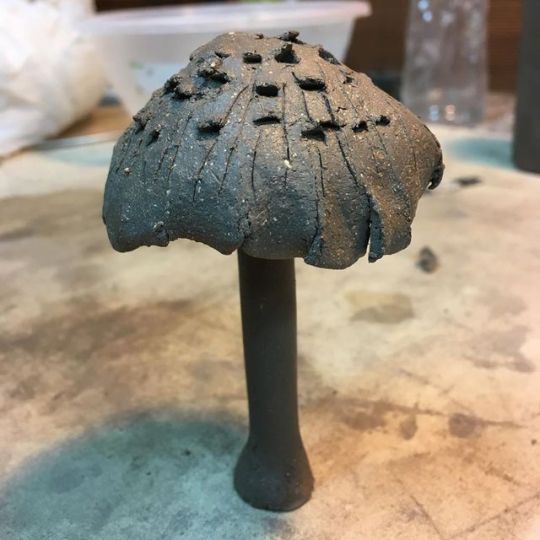
🍄 de cerámica Gres en proceso de secado ! #hymenochaetaceae#coprinus comatus #reinofungi#hongosdechile#cerámicagres#esculturacerámica (en Melosilla) https://www.instagram.com/p/Bx-6vE_AyRJ/?igshid=14fz0d8arudji
0 notes
Text





Inonotus obliquus, commonly called chaga, is a fungus in the family Hymenochaetaceae. It is parasitic on birch and other trees. The sterile conk is irregularly formed and resembles burnt charcoal.

Animal and test-tube studies found that chaga extract may boost immunity, prevent chronic inflammation, fight cancer, lower blood sugar levels and reduce cholesterol.
We spent the afternoon hiking and found some up in the birch trees. We took it home and dried it all, placing it in jars for the future.
Take a chunk and simmer for three hours by placing it to steep on something warm like a stovetop or perhaps the wood stove.
It has a slight vanilla flavour and is a wonderful coffee replacement.
9 notes
·
View notes
Text

This is ... exciting. I don’t much about fungus, but I’ll try to summarize: Basically, many people celebrate and revere “chaga” (Inonotus obliquus), the fungus famous for its apparently-genuine cancer-fighting properties and its popular use as a folk medicine, especially in northern and eastern Europe. Chaga is parasitic, and prefers to infect birch trees, though it can also use some other hardwoods trees as hosts. It lives in forested environments at higher latitudes and in boreal environments of Eurasia, and also exists in Japan and in North American forests near the Great Lakes, New England, Pacific Northwest, and regions farther north. And the fungus life history is very mysterious. It apparently only reproduces once during its entire lifetime on a host tree, if at all. And the reproductive phase of the fungus is rarely seen. However - and, this isn’t entirely confirmed yet, but - there is recent evidence that fungus-eating beetles may play a role in ingesting and spreading chaga’s spores, with the insects aiding in reproduction and dispersal. This revelation comes from a “mother tree” of reproducing chaga in forest near the Quebec-Vermont border. And, there is precedent for this possibility that beetles aid in chaga’s dispersal. Previously, the “only other polypore species that forms a fruiting body under bark is Inonotus andersonii” which is relatively closely-related to chaga, and which infects oak trees in the American Southwest; fungus-eating beetles have been suspected to be important to Inonotus andersonii’s reproduction and dispersal.
Previously, in 2015, Britt A. Bunyard published this in peer-reviewed Proceedings of the Entomological Society of Washington: “First Record of Insect Mycophagy of the Commercially-Important “Chaga” Fungus Inonotus obliquus (Ach. Ex Pers.) Pilát (Hymenochaetales: Hymenochaetaceae) in North America.” Here is an excerpt from that abstract: “Despite its universal recognizability, many questions about the basic biology of this fungus remain, including sexual reproduction and spore dispersal which has rarely been seen. Mycophagous beetles have been hypothesized as having a role. This is the first report of insect mycophagy of I. obliquus in North America, and these findings suggest that O. cultriformis may play a role in spore dispersal of this enigmatic fungus.”
And the following excerpts were published by Britt A. Bunyard and Sarah Dole in the Winter 2018 edition of FUNGI.


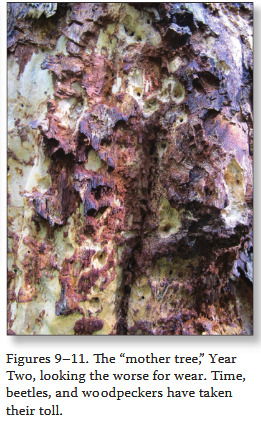

The chaga canker is commonly seen in birch forests but the sexual reproductive structure (“basidiocarp” or “sporocarp,” Figs. 2–3) is rarely seen (Gilbertson and Ryvarden, 1986; Bondartsev, 1971). Indeed a connection between the two structures wasn’t even proposed until as recently as 1938 (Campbell and Davidson, 1938; Millman, 2012). Moreover, a number of factors about the reproductive biology of I. obliquus are enigmatic. The basidiocarp is actually little more than a resupinate (crustose) layer of tubes that form on a recently dead host tree. The fungus does not seem to fruit more than one time during the host’s lifetime (Gilbertson and Ryvarden, 1986) and most host trees killed by the fungus may never show any sign that the fungus has gone through sexual reproduction. [...]
The only other polypore species that forms a fruiting body under bark is Inonotus andersonii (Millman, 2012), one of the primary causes of mortality among oaks in southwestern North America. When the spore-forming resupinate layer forms on host trees it seems to quickly attract mycophagous insects (Gilbertson and Ryvarden, 1986) and primarily beetles (Bunyard, 2015; Bondartsev, 1971). Bondartsev (1971) noted that the fruitbody, when rarely seen, is usually little more than a mass of tunnels and beetle frass and is all but unrecognizable. Based on the attraction by beetles, and the unusual location of fruiting (beneath the host tree’s bark), beetles have been suspected to play a role in spore dispersal of this fungus (Millman, 2012). [...]
So it was met with great excitement when one of us (SD) had located a huge fruiting of this fungus on a recently dead yellow birch tree, Betula alleghaniensis, near her home, in Quebec, Canada, approximately 20-25 feet north of the border of Essex County, Vermont (45.012815, -71.611770). Many trips to the “mother tree” were made to observe and collect any insects that arrived and seemed interested in this fruitbody. Many adults and larva of the beetle Orchesia cultriformis (Family Melandryidae) were observed feeding on the reproductive tissue of the fungus and collected in jars of alcohol (Figs. 4–7). Beetle IDs were made with the assistance of Margaret K. Thayer, Curator Emeritus of the Field Museum of Natural History (Chicago, IL). Three adults and one larva were dissected and photographed under microscopy (by FR), with their gut contents all found to contain hyphae and spores positively identified to be those of I. obliquus. [...]


Although this was a first-ever account of insect mycophagy (and potential spore dissemination) of the chaga fungus in North America, insect, and especially beetle spore dispersal is known. Overall, arthropods are well-known vectors of spores of many disparate groups of fungi including rusts, smuts, yeasts, and stinkhorns (for a review, see Ingold, 1971).
Talbot (1952) showed a number of invertebrates that inhabit wood and bark could ingest and then pass viable mycelium and spores (endozoochory) of polypores. More recently, mycophagous Diptera (Bunyard, 2003; Lim, 1977; Tuno, 1999) and mycophagous coleopterans (Nuorteva and Laine, 1972) also were shown to pass viable mycelium and spores of polyporoid fungi. Most recently Lilleskov and Bruns (2005) showed a number of different arthropods could ingest and pass viable spores of a widespread resupinate mycorrhizal fungus (Tomentella sublilacina)

Although this current study provides some evidence of zoochory by beetles, to date, no study has determined positively that any animals play a role in spore dispersal for I. obliquus. Schigel (2011), in one of the few studies on polypore-associated insects to include I. obliquus, found that,in Finland, the larvae and adults of several species of mycophagous and polyphagous beetles are the primary consumers. Orchesia micans was noted as being the most commonly reared from I. obliquus in their study. Beetles of Family Melandryidae (“false darkling beetles”) are commonly found under the bark of mature and rotting trees, and are thought to feed on rotting wood (xylophagous) or fungal hyphae (mycetophagous). Melandryids have been poorly studied (Leschen, 1990; Majka and Pollock, 2006) and their life histories have seldom been described (LeSage, 1991), with most collections coming from adults collected in traps and thus there is no knowledge of larval life histories.

--
@bigancestorenergy - This is that article!
Cool stuff.
26 notes
·
View notes
Photo

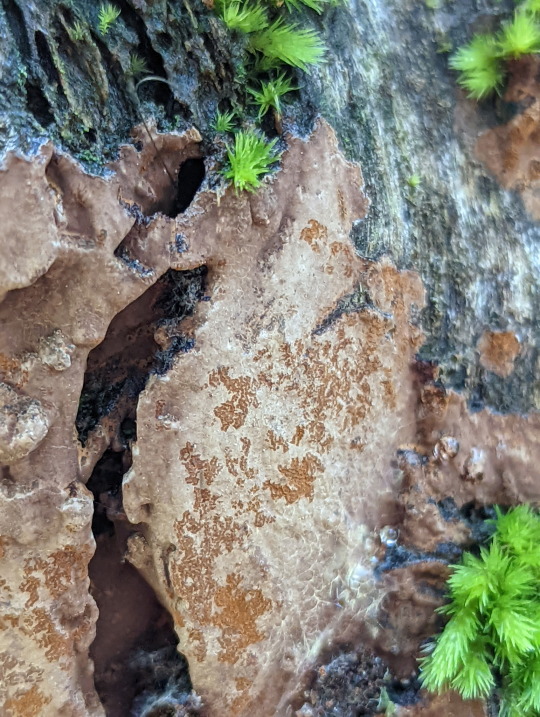


Bark-Like Fungi
Unidentified, family Hymenochaetaceae
06/07/22
#Hymenochaetaceae#fungi#fungus#mycology#Basidiomycota#Basidiomycete Fungi#Agaricomycotina#Higher Basidiomycetes#Unidentified
25 notes
·
View notes
Text
Chaga Mushroom Market Revolutionary Opportunities 2028
Chaga Mushroom Market
Mushrooms are viewed as extraordinary wellsprings of fundamental supplements, like proteins, filaments, nutrients, calcium, minerals, and selenium. Mushrooms are generally devoured across the globe for their impressive medical advantages – they help in weight the board, they can be utilized to support resistance, they can annihilate dangerous cells and accordingly, help in working on by and large nourishment and advancing a solid way of life. Chaga mushroom is an organism having a place with the family Hymenochaetaceae. Chaga mushroom is normally discovered developing on birch trees and less ordinarily on different trees, like oak, birch, beech, and others. Chaga mushroom is for the most part filled in Russia as this mushroom fills well in cool environments.
Read report Overview-
https://www.transparencymarketresearch.com/chaga-mushroom-market.html
Customers are searching for food items with potential medical advantages, which has been pushing the fuse of solid fixings in different consumable items. Chaga mushroom comprises of most significant levels of Superoxide Dismutase (SOD), which is viewed as perhaps the most impressive cell reinforcement and mitigating substance, and specialists, presently, are researching it’s anything but an enemy of maturing item.
Additionally, a few research have shown that chaga mushrooms can be utilized to repress the movement of malignant cells and animate one’s insusceptible framework, along these lines making chaga a natural reaction modifier. Aside from this, chaga mushroom has likewise been known to assist with combatting different infections, like diabetes and cholesterol, and further develop assimilation.
Chaga mushroom has for some time been utilized for its possible applications in keeping a solid stomach-related framework. This will additionally push the market for chaga mushrooms across the globe. Developing a pattern of practical food fixings and expanding utilization of chaga mushrooms as a solid supplement is required to assist with speeding up the market development of chaga mushrooms sooner rather than later.
Get Brochure of the Report @
https://www.transparencymarketresearch.com/sample/sample.php?flag=B&rep_id=43277
Market Outlook
Mushrooms are regarded as great sources of essential nutrients, such as proteins, fibers, vitamins, calcium, minerals and selenium. Mushrooms are widely consumed across the globe for their considerable health benefits – they help in weight management, they can be used to boost immunity, they can destroy cancerous cells and thus, help in improving overall nutrition and promoting a healthy lifestyle. Chaga mushroom, also refereed to as Inonotus obliquus, is a fungus belonging to the family Hymenochaetaceae. Chaga mushroom is commonly found growing on birch trees and less commonly on other trees, such as alder, oak, beech and others. Chaga mushroom is mostly grown in Russia as this mushroom grows well in cold climates. Consumption of chaga mushroom is highly concentrated across the European and American regions due to greater demand for these mushrooms as an essential source of antioxidant and due to its use in the production of chaga tea. Furthermore, chaga mushroom has also been in focus due to its medicinal properties, which has further been strengthening the market for chaga mushrooms across the globe. The global chaga mushroom market is expected to benefit from growing consumers’ demand for healthy and organic products.
Enquiry before buying :
https://www.transparencymarketresearch.com/sample/sample.php?flag=EB&rep_id=43277
Reasons for Covering this Title
Today, consumers are looking for food products with potential health benefits, which has been pushing the incorporation of healthy ingredients in various edible products. Chaga mushroom consists of highest levels of Superoxide Dismutase (SOD), which is considered to be one of the most powerful antioxidant and anti-inflammatory substance and researchers, now, are investigating its potential as an anti-aging product. Also, several research studies have demonstrated that chaga mushrooms can be used to inhibit the progression of cancerous cells and stimulate one’s immune system, thereby making chaga a biological response modifier. Apart from this, chaga mushroom has also been known to help combat other diseases, such as diabetes and cholesterol and improve digestion. Chaga mushroom has long been used for its potential applications in maintaining a healthy digestive system. This will further push the market for chaga mushrooms across the globe. Growing trend of functional food ingredients and increasing consumption of chaga mushroom as a healthy nutrient is expected to help accelerate the market growth of chaga mushrooms in the near future.
Global Chaga Mushroom: Market Segmentation
On the basis of nature, the global chaga mushroom market has been segmented as –
Organic
Conventional
On the basis of form, the global chaga mushroom market has been segmented as –
Chaga Mushroom Powder
Chaga Mushroom Liquid
On the basis of application, the global Chaga Mushroom market has been segmented as –
Antioxidant
Immune Booster
Alkalizing
Anti-Inflammatory
Others
On the basis of distribution channel, the global chaga mushroom market has been segmented as –
Direct
Indirect
Store Based Retailing
E-Commerce
Hypermarket/supermarket
Discount Stores
Independent Grocery Stores
Others
More Trending Report by Transparency Market Research –
https://www.prnewswire.com/news-releases/turmeric-oleoresin-market-to-reach-valuation-of-us-165-7-mn-by-2032–notes-tmr-study-301505295.html
Global Chaga Mushroom Market: Key Players
Some of the key players operating in the global Chaga Mushroom market are Annanda Chaga Mushrooms., Baikal Herbs, Lingonberry Group, Sayan Health, Chaga Mountain, Bioway (Xi’an) Organic Ingredients Co. Ltd, Chaga Mountain, Inc., Eartherbs L.L.C and Four Sigmatic, among others.
About Us Section:
Transparency Market Research is a global market intelligence company, providing global business information reports and services. Our exclusive blend of quantitative forecasting and trends analysis provides forward-looking insight for thousands of decision makers. Our experienced team of Analysts, Researchers, and Consultants, use proprietary data sources and various tools and techniques to gather, and analyse information. Now avail flexible Research Subscriptions, and access Research multi-format through downloadable databooks, infographics, charts, interactive playbook for data visualization and full reports through MarketNgage, the unified market intelligence engine. Sign Up for a 7 day free trial!
Contact
Rohit Bhisey
Transparency Market Research,
90 State Street, Suite 700,
Albany, NY 12207
Tel: +1-518-618-1030
USA – Canada Toll Free: 866-552-3453
Email: [email protected]
Website: https://www.transparencymarketresearch.com/
0 notes
Photo

As Mr. Tree raised his branch in welcome, he exposed an unsightly growth #fungusamongus #fungus #inonotus “Inonotus is a genus of fungi in the family Hymenochaetaceae. The genus, described by Petter Karsten in 1879, is estimated to contain about 80 species sensu lato and 30 species sensu stricto. The name comes from ino meaning fibrous and ot meaning ear. Genus: Inonotus; P.Karst. (1879) Family: Hymenochaetaceae Class: Agaricomycetes Order: Hymenochaetales” - Wikipedia #nature #naturephotography (at Jacksonville, Florida) https://www.instagram.com/p/CRNS2BvL8dK/?utm_medium=tumblr
0 notes
Text
Chaga Mushroom Market Future Growth Explored in Latest Research Report
Mushrooms are regarded as great sources of essential nutrients, such as proteins, fibers, vitamins, calcium, minerals and selenium. Mushrooms are widely consumed across the globe for their considerable health benefits – they help in weight management, they can be used to boost immunity, they can destroy cancerous cells and thus, help in improving overall nutrition and promoting a healthy lifestyle.
Chaga mushroom, also refereed to as Inonotus obliquus, is a fungus belonging to the family Hymenochaetaceae. Chaga mushroom is commonly found growing on birch trees and less commonly on other trees, such as alder, oak, beech and others. Chaga mushroom is mostly grown in Russia as this mushroom grows well in cold climates. Consumption of chaga mushroom is highly concentrated across the European and American regions due to greater demand for these mushrooms as an essential source of antioxidant and due to its use in the production of chaga tea. Furthermore, chaga mushroom has also been in focus due to its medicinal properties, which has further been strengthening the market for chaga mushrooms across the globe. The global chaga mushroom market is expected to benefit from growing consumers’ demand for healthy and organic products.
Reasons for Covering this Title
Today, consumers are looking for food products with potential health benefits, which has been pushing the incorporation of healthy ingredients in various edible products. Chaga mushroom consists of highest levels of Superoxide Dismutase (SOD), which is considered to be one of the most powerful antioxidant and anti-inflammatory substance and researchers, now, are investigating its potential as an anti-aging product. Also, several research studies have demonstrated that chaga mushrooms can be used to inhibit the progression of cancerous cells and stimulate one’s immune system, thereby making chaga a biological response modifier. Apart from this, chaga mushroom has also been known to help combat other diseases, such as diabetes and cholesterol and improve digestion. Chaga mushroom has long been used for its potential applications in maintaining a healthy digestive system. This will further push the market for chaga mushrooms across the globe. Growing trend of functional food ingredients and increasing consumption of chaga mushroom as a healthy nutrient is expected to help accelerate the market growth of chaga mushrooms in the near future.
Request for Report Sample @ https://www.transparencymarketresearch.com/sample/sample.php?flag=S&rep_id=43277
Global Chaga Mushroom Market: Key Players
Some of the key players operating in the global Chaga Mushroom market are Annanda Chaga Mushrooms., Baikal Herbs, Lingonberry Group, Sayan Health, Chaga Mountain, Bioway (Xi’an) Organic Ingredients Co. Ltd, Chaga Mountain, Inc., Eartherbs L.L.C and Four Sigmatic, among others.
Key Developments
On December, 2016, ChugaChaga Inc. which is a New York-based beverage manufacturer, launched a range of bottled tea drink for health conscious consumers. The drink comes in various flavours, such as peach and classic as well as with zero sugar.
In January 2015, Four Sigmatics, which is a U.S.-based manufacturer of super foods, medicinal mushrooms and adaptogenic herbs, launched eight drink mixes, including two coffee mixes, made with chaga for better immune support.
Explore Transparency Market Research’S Award-Winning Coverage of the Global Industry @ https://www.prnewswire.com/news-releases/base-oil-market-to-reach-valuation-of-usd-42-billion-by-2030-transparency-market-research-301080865.html
Opportunities for Market Participants
Medicinal mushrooms have immense health benefits and have been used since ages for the treatment of several diseases. The growing trend of functional food ingredients has been pushing the demand for healthy beverages. This coupled with growing consumers’ interest in natural products with unique product positioning will lead to the growth of the Chaga mushroom market. Chaga mushroom is regarded as one of the most powerful adaptogens and has been found to be beneficial in preventing premature ageing. Escalating demand for healthy beverages and growing clean label trend is expected to push the market revenue in the overall chaga mushroom market in near future.
Request for Covid-19 Impact Analysis @ https://www.transparencymarketresearch.com/sample/sample.php?flag=covid19&rep_id=43277
0 notes
Text
Chaga Mushroom Market : Key Players and Production Information analysis with Forecast 2018 – 2028
Mushrooms are regarded as great sources of essential nutrients, such as proteins, fibers, vitamins, calcium, minerals and selenium. Mushrooms are widely consumed across the globe for their considerable health benefits – they help in weight management, they can be used to boost immunity, they can destroy cancerous cells and thus, help in improving overall nutrition and promoting a healthy lifestyle. Chaga mushroom, also refereed to as Inonotus obliquus, is a fungus belonging to the family Hymenochaetaceae.
Request to view Brochure Report:
https://www.transparencymarketresearch.com/sample/sample.php?flag=B&rep_id=43277
Chaga mushroom is commonly found growing on birch trees and less commonly on other trees, such as alder, oak, beech and others. Chaga mushroom is mostly grown in Russia as this mushroom grows well in cold climates. Consumption of chaga mushroom is highly concentrated across the European and American regions due to greater demand for these mushrooms as an essential source of antioxidant and due to its use in the production of chaga tea. Furthermore, chaga mushroom has also been in focus due to its medicinal properties, which has further been strengthening the market for chaga mushrooms across the globe. The global chaga mushroom market is expected to benefit from growing consumers’ demand for healthy and organic products.
Today, consumers are looking for food products with potential health benefits, which has been pushing the incorporation of healthy ingredients in various edible products. Chaga mushroom consists of highest levels of Superoxide Dismutase (SOD), which is considered to be one of the most powerful antioxidant and anti-inflammatory substance and researchers, now, are investigating its potential as an anti-aging product. Also, several research studies have demonstrated that chaga mushrooms can be used to inhibit the progression of cancerous cells and stimulate one’s immune system, thereby making chaga a biological response modifier.
Apart from this, chaga mushroom has also been known to help combat other diseases, such as diabetes and cholesterol and improve digestion. Chaga mushroom has long been used for its potential applications in maintaining a healthy digestive system. This will further push the market for chaga mushrooms across the globe. Growing trend of functional food ingredients and increasing consumption of chaga mushroom as a healthy nutrient is expected to help accelerate the market growth of chaga mushrooms in the near future.
Request to view Customization Report:
https://www.transparencymarketresearch.com/sample/sample.php?flag=CR&rep_id=43277
Medicinal mushrooms have immense health benefits and have been used since ages for the treatment of several diseases. The growing trend of functional food ingredients has been pushing the demand for healthy beverages. This coupled with growing consumers’ interest in natural products with unique product positioning will lead to the growth of the Chaga mushroom market. Chaga mushroom is regarded as one of the most powerful adaptogens and has been found to be beneficial in preventing premature ageing. Escalating demand for healthy beverages and growing clean label trend is expected to push the market revenue in the overall chaga mushroom market in near future.
A modelling-based approach and triangulation methodology will be followed to estimate data covered in this report. A detailed market understanding and assessment of the nature, product type and end uses of the product segments covered in the study is followed by carrying out a demand-side approach to estimate the sales of target product segments, which is then cross-referenced with a supply-side assessment of value generated over a pre-defined period. The statistics and data is collected at a regional level, consolidated and synthesized at a global level to estimate the overall market sizes.
0 notes